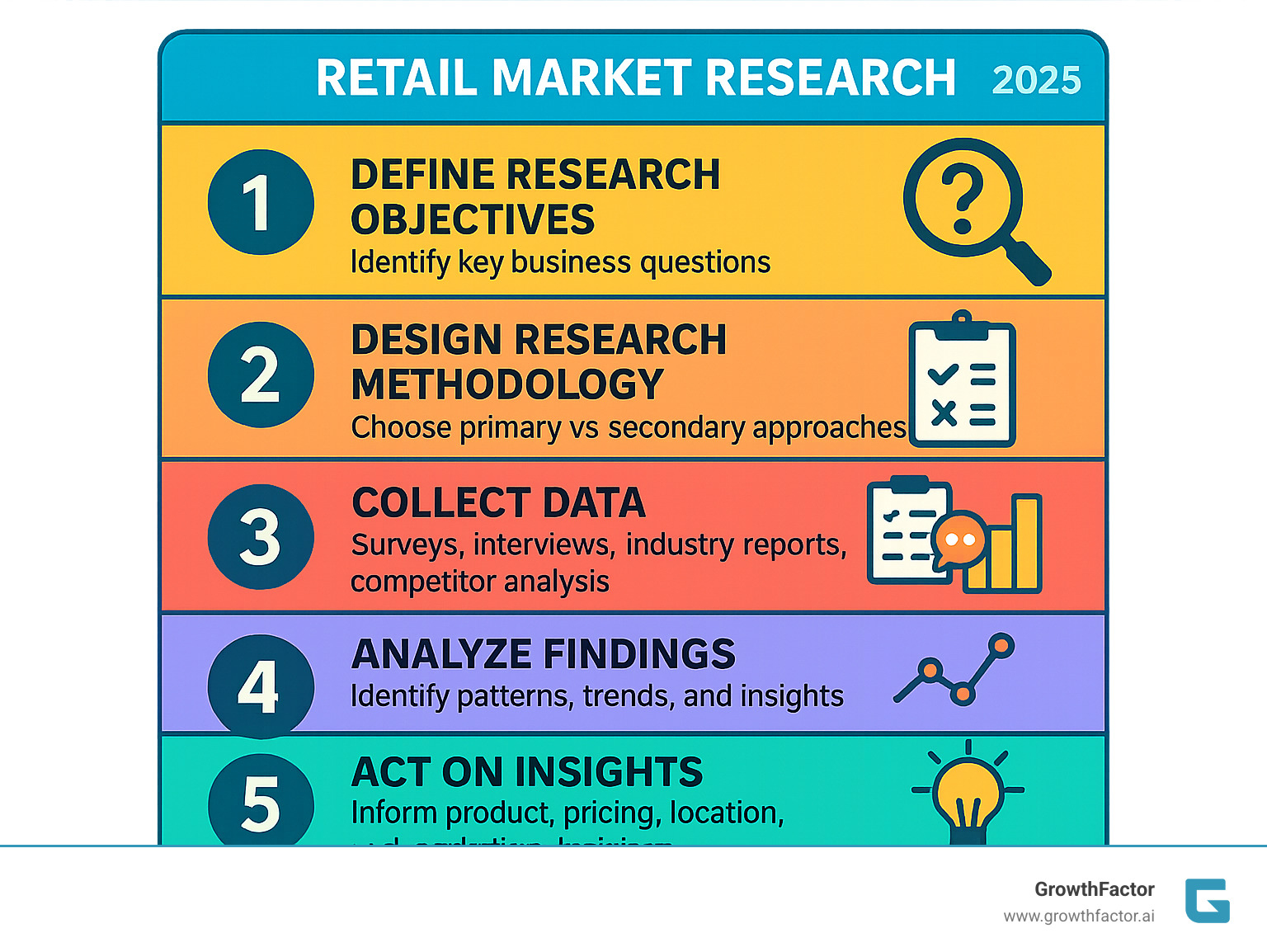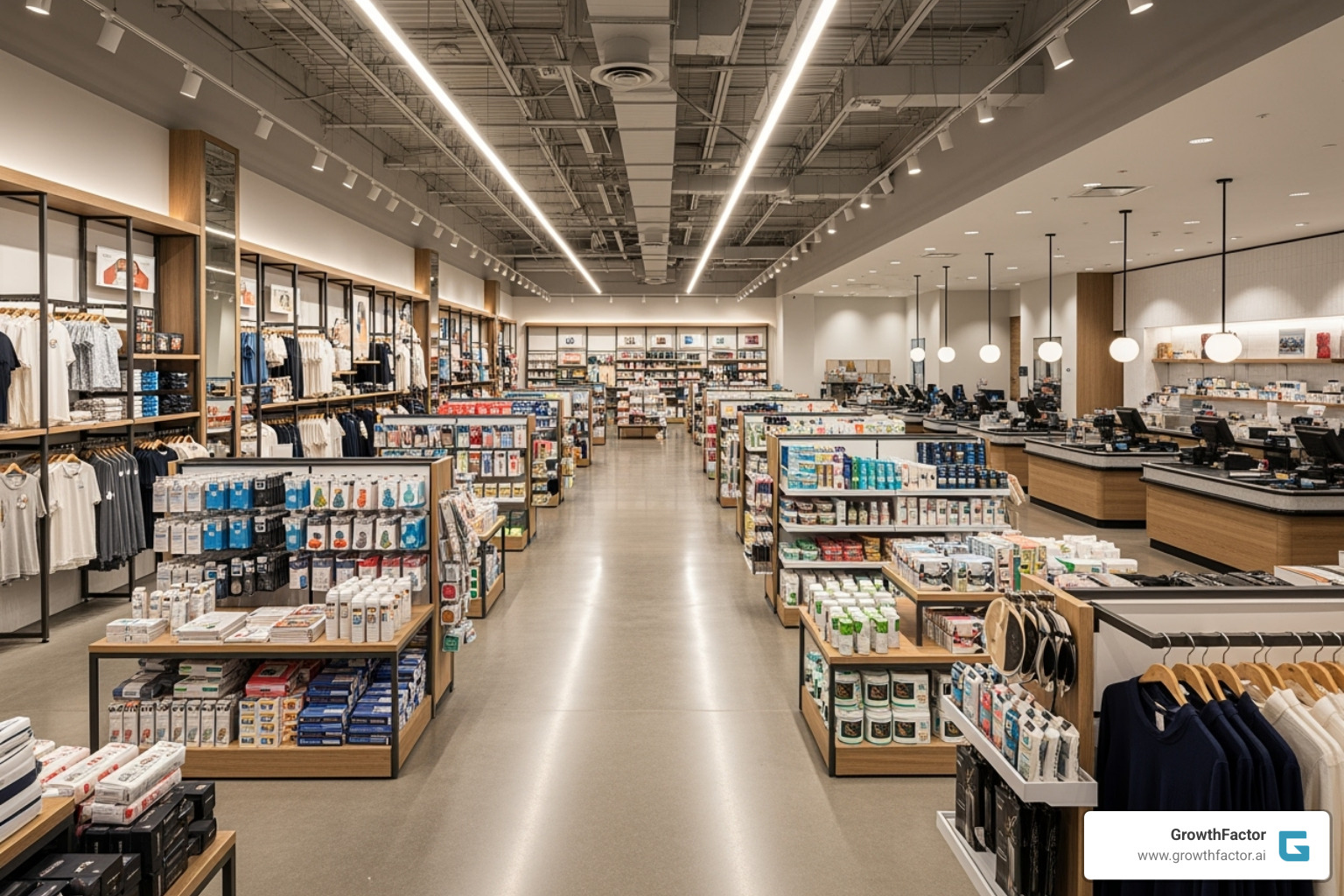The Retail Detective: Mastering Market Research for Your Business
Written by: Clyde Christian Anderson
Why Every Retailer Needs a Market Research Magnifying Glass

Retail market research is the systematic process of gathering and analyzing data about your target market, customers, and competitors to make informed business decisions. In a volatile landscape where brand loyalty is fading, effective market research isn't optional—it's essential for survival.
Quick Answer: How to Conduct Retail Market Research
- Define your objectives - What business decisions need data support?
- Choose your research type - Primary (surveys, interviews) or secondary (industry reports, government data)
- Collect data systematically - Use multiple methods for comprehensive insights
- Analyze findings - Look for patterns, trends, and actionable insights
- Apply insights strategically - Inform product, pricing, location, and marketing decisions
With high inflation and fierce competition, the retail industry's main challenge is finding the right products and presenting them effectively. Market research is the magnifying glass retailers need to examine consumer behavior, spot opportunities, and avoid costly mistakes.
Consumer behavior is shifting rapidly. While brick-and-mortar remains relevant, online shopping has surged, with 70% of younger customers using social channels for findy and 82% favoring stores with loyalty programs. Staying competitive requires keeping up with these changes.
The financial impact is significant. Companies using retail market research can open up millions in revenue and cash flow. It provides the confidence to launch successful new products and create benchmarks for future projects.
I'm Clyde Christian Anderson, Founder and CEO of GrowthFactor.ai. I've seen how data-driven retail market research and site selection strategies transform expansion from guesswork into a strategic advantage, helping our clients open up significant revenue and cash flow.

Basic retail market research vocab:
The Core Objectives of Retail Investigation
Effective retail market research illuminates the path to smarter business decisions. Core objectives include:
- Achieve Product-Market Fit: Offer what customers truly want by understanding their preferences and unmet needs.
- Clarify Your Target Audience: Define your ideal customers—their demographics, habits, and motivations—to tailor products and messaging.
- Improve Customer Experience: Identify and fix pain points in-store and online by gathering direct feedback.
- Increase Product Launch Success: Mitigate financial risk by testing concepts and gauging demand before a full rollout.
- Optimize Pricing: Find the sweet spot that is both attractive to customers and profitable for your business.
- Improve Marketing Messages: Craft campaigns that resonate by understanding your audience's preferences and behaviors.
- Gain a Competitive Edge: Analyze rivals' strategies to identify your unique selling propositions and differentiate your brand.
Common Mistakes to Avoid in Your Research
Poorly executed retail market research can lead to costly mistakes. Avoid these common pitfalls:
- Relying on Unverified Data: Free internet data can be outdated or inaccurate. Always verify sources and use authoritative reports.
- Surveying Only Your Personal Network: This creates a biased sample. Reach a diverse group that represents your true target market.
- Depending on Anecdotal Feedback: Individual stories are insightful but must be validated with broader data to be significant.
- Using Poorly Designed Surveys: Ambiguous or leading questions yield useless data. A clear plan is essential.
- Ignoring Competitor Analysis: Understanding competitors' strategies is crucial for identifying threats and opportunities.
- Failing to Act on Insights: The biggest mistake is gathering data and then doing nothing. Research must inform strategic action.
The Retail Detective's Toolkit: A Guide to Retail Market Research Methods

Your toolkit for retail market research is filled with methods to transform raw data into actionable intelligence. The key is knowing which tool to use and when, combining different approaches for a complete picture.
Primary vs. Secondary: Choosing Your Retail Market Research Approach
Your first decision is whether to use primary or secondary research.
Primary research involves collecting new data directly from consumers. It's ideal for answering specific questions about your business, like why customers prefer one location or what features they want in a new product. You control the entire process.
Secondary research uses existing data from sources like industry reports and government agencies. It's faster and more cost-effective, providing broad market context before you dive into specifics.
| Feature | Primary Research | Secondary Research |
|---|---|---|
| Data Source | Original, collected directly by us | Existing, collected by others and publicly available |
| Specificity | Highly specific to our research questions | Broad, may not perfectly fit our exact needs |
| Cost | Generally higher (time, effort, resources) | Generally lower (often free or subscription-based) |
| Speed | Slower (requires planning, execution, analysis) | Faster (data is already compiled) |
| Control | Full control over methodology and data quality | No control over methodology or original data quality |
| Examples | Surveys, interviews, focus groups, observations | Industry reports, government data, academic studies |
The smartest approach combines both. Start with secondary research to understand market trends, then use primary research to dig into the specific preferences of your ideal customers. This combination is particularly powerful for retailers considering new locations.
For more insights on location strategy, check out our resources on data-driven site selection. For industry context, sources like Statista offer valuable secondary data.
Effective Primary Research Methods
When you need fresh insights, primary research methods provide direct answers to your unique business challenges.
- Customer Surveys: A versatile tool for gathering quantitative data. Intercept surveys capture in-the-moment feedback in-store, while online surveys reach a broad audience efficiently.
- In-depth Interviews: One-on-one conversations that reveal the "why" behind customer actions, uncovering insights that surveys might miss.
- Focus Groups: Moderated discussions with small groups (6-10) of target customers to explore opinions and generate ideas through group dynamics.
- Shop-alongs: Observe customers in real-time as they steer your store (or a competitor's) to see the gap between what they say and what they do.
- Mystery Shopping: Use trained evaluators posing as customers to get an unbiased assessment of your store operations, from staff performance to cleanliness.
- Sentiment Analysis: Analyze online reviews and social media comments to gauge public opinion and identify trends in customer feedback.
- Sales Data Analysis: Treat your internal sales records as primary data to identify patterns across locations, seasons, and customer segments.
Combining these methods provides a comprehensive view. For deeper insights into optimizing your location strategy, our guide to retail site location analysis offers practical frameworks.
Leveraging Secondary Data for a Broader View
Secondary data provides the essential context for your research, offering a cost-effective way to understand the broader retail landscape.
- Industry Reports: Get comprehensive overviews of retail sectors, including market size, growth forecasts, and competitive analysis from firms like IBISWorld and Mintel.
- Government Data: Access reliable demographic information, income levels, and consumer spending patterns from sources like Statistics Canada and the US Census Bureau. For global data, the OECD iLibrary for trade data is invaluable.
- Trade Association Publications: Gain insider perspectives and learn about emerging challenges and best practices within specific retail segments.
- Competitor Annual Reports: Analyze the 10-K filings of public competitors to understand their financial performance, strategic priorities, and market share.
- News Articles and Business Publications: Stay on top of emerging trends and significant industry shifts that could impact your business.
- Academic Studies: Leverage rigorous, unbiased analysis of consumer psychology and retail dynamics from university researchers.
Weaving these sources together builds a strong foundation for your primary research. AI tools can accelerate this analysis; our insights on AI real estate market analysis show how technology can help.
From Insights to Impact: Applying Research to Drive Retail Growth

In retail market research, the goal is to transform data into strategic decisions that drive business growth. This is where insights become action, and action becomes results. Well-executed research touches every corner of a retail operation, from product selection to marketing campaigns.
Using Research to Inform Key Retail Decisions
Research guides the most critical areas of your retail business, turning guesswork into a science.
- Product Assortment: Use consumer insights from methods like MaxDiff and TURF analysis to stock the colors, styles, and features customers actually want.
- Pricing Strategy: Move beyond balancing acts to data-driven decisions. Research reveals customer price sensitivity and competitive benchmarks, helping you find the profitable sweet spot.
- Store Layout and Design: Use shop-alongs and intercept surveys to identify friction points in your physical and digital stores, improving customer flow and navigation. Our guide on how to choose a retail location dives deeper.
- Marketing Campaigns: Build campaigns on solid research. Knowing where your audience spends their time (e.g., social media for Gen Z) ensures your message hits the mark.
- Customer Service Protocols: Evolve service based on real feedback, pinpointing where improvements will have the biggest impact on satisfaction and loyalty.
- Competitive Analysis: Benchmark your performance, analyze competitor strategies, and identify market gaps to create differentiation.
Real-world examples prove the power of this approach. Crocs achieved massive growth by using research to pivot toward digital marketing and fashion-forward markets. Walmart's 'kidult' strategy successfully targeted adults buying toys for themselves after research identified the trend.
Future-Proofing Your Strategy: The Latest Trends in Retail Market Research

The retail landscape is always changing, and your research methods must evolve to keep pace.
- Artificial Intelligence (AI): AI is revolutionizing data analysis. It powers personalization engines, improves demand forecasting, and improves customer service through chatbots. At GrowthFactor, our AI Agent Waldo enables teams to evaluate five times more sites by automating qualification and evaluation.
- Social Media Monitoring: Tap into organic online conversations to understand real-time customer sentiment and emerging trends, providing authentic qualitative data.
- Geofencing Technology: Capture feedback at the point of purchase by engaging with customers when they are near or inside your stores.
- Omnichannel Data Integration: Create a complete picture of the customer journey by integrating data from all touchpoints—physical stores, websites, apps, and social media.
- Predictive Analytics: Move from reactive to proactive decisions by using historical data and statistical models to forecast consumer demand and market shifts.
- Sustainable and Ethical Consumerism: Research consumer interest in eco-friendly products and circular economy models to align your brand with growing values.
These trends are powerful tools for staying agile. For more on how AI is shaping retail, explore our resource on AI powered retail analytics.
Measuring Success and Driving Growth with Your Findings
The final step is to prove your retail market research pays off by tracking Key Performance Indicators (KPIs) tied to your objectives.
- Return on Investment (ROI): Did the research lead to increased sales or reduced costs that justify the investment?
- Customer Lifetime Value (CLV): Are research-informed strategies increasing customer retention and spending over time?
- Net Promoter Score (NPS) & Customer Satisfaction (CSAT): Are customers happier and more likely to recommend you?
- Conversion Rates: Are more browsers turning into buyers after your changes?
- Market Share Growth: Are you capturing a larger slice of the market?
- Product Launch Success: Are new products meeting or exceeding sales projections?
Market research is a continuous cycle: listen, learn, adapt, and grow. Establish benchmarks, implement changes, and measure against them to gauge effectiveness.
At GrowthFactor, we turn complex data into actionable growth. Our AI-powered platform streamlines site selection and deal tracking, giving you the intelligence to thrive. We offer solutions custom to your needs, from our Core plan to Enterprise-level tools.
By consistently applying research insights and leveraging cutting-edge tools, retailers can flourish in any market. Explore how our solutions can help your brand at Find AI-powered solutions for retail brands.
Citations
The human algorithm
Request Your demo
Schedule meeting
Or submit your information below and we'll be in touch to schedule.


